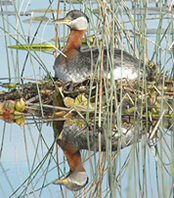Streams & Wetlands
Wetlands and riparian areas, where water and land come together, are some of the most productive and valuable of Montana’s natural areas, providing a wide variety of environmental and human benefits. The benefits of these resources for local communities include:
- Improving water quality by filtering sediments and toxins out of water;
- Recharging wells and ground water supplies;
- Providing flood control;
- Enriching open space;
- Increasing real property values and marketability because of aesthetic attributes;
- Enhancing fish and wildlife habitat; and
- Improving recreational opportunities.
The best inventory completed shows Montana’s wetland, riparian, and water resources occupy 4.3% of the state, which is made up the following (Source: MT Natural Heritage Program, May 15, 2015):
- Water area in Montana = 956,102 acres = 1.0% of Montana
- Wetlands = 2,435,123 acres = 2.6% of Montana
- Riparian = 627,650 acres = 0.7% of Montana
The information below describes the importance of this habitat to fish and wildlife, specific wetland/riparian habitat types found in Montana, and conservation measures that can be used to protect these sensitive areas.
Montana’s Wildlife Depends on Wetlands & Riparian Areas
Wetlands, riparian areas, and water are particularly important habitats for wildlife.
- Mammals: Important seasonal or year-round habitat for at least 56 of Montana’s mammals, including 36 species of small mammals (rodents, rabbits, and shrews), 8 bats, 7 carnivores (otter, weasels, racoons, and skunks), and 4 ungulates (white-tailed and mule deer, moose, and pronghorn). (Source MT Fish, Wildlife & Parks)
- Birds (Source: 2012 edition of M
 T Bird Distribution):
T Bird Distribution):
- Breeding Birds: Breeding and nesting areas for at least 52% of Montana’s breeding bird species (102 of Montana’s 260 breeding birds)
- Migrating Birds: Much-needed food and resting areas for 65% of the birds that routinely migrate through Montana (51 of the 77 bird species that regularly migrate through Montana). Temporary wetlands that only have water in the spring are particularly important.
- Species of Concern: 30 of Montana’s 66 bird species of concern (46%).
- Reptiles and Amphibians: Essential breeding, foraging, and over-wintering habitat for Montana’s 16 native amphibians (salamanders, frogs, and toads), 3 turtles, and at least 7 of Montana’s snakes (Source MT Fish, Wildlife & Parks)
- Fish: 100% of the habitat for Montana’s 85 species of fish that depend on healthy streams, including 51 species of native fish and 32 non-native (introduced) fish.
Cottonwood Habitat
Cottonwood forests provide habitat for more than half the bird species in Montana, while hundreds of thousands of spring and fall migrating birds seek these riparian corridors for food and shelter. In the western United States, they support a higher diversity of breeding birds than all other western habitats combined. Click here for more.
Wetland
Wetlands and riparian areas make up less than 3.3 percent of Montana’s land base, yet remain the most important wildlife habitat in our state. However, the same places that attract wildlife are also attractive to people. The protection and enhancement of Montana’s remaining wetlands is a priority issue for Montana Audubon. Because of this, we have initiated a series of projects, described below, that are designed to provide citizens and local government officials with the information they need to protect these important areas. Click here for more.